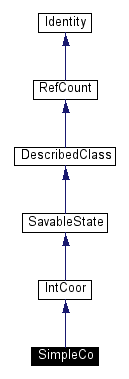
#include <simple.h>
Inheritance diagram for SimpleCo


Public Methods | |
| SimpleCo () | |
| SimpleCo (int, const char *=0) | |
| This constructor takes an integer argument which is the number of atoms needed to describe the coordinate. More... | |
| SimpleCo (const Ref< KeyVal > &,int natom) | |
| The KeyVal constructor requires the number of atoms. | |
| virtual | ~SimpleCo () |
| int | natoms () const |
| Returns the number of atoms in the coordinate. | |
| int | operator[] (int i) const |
| Returns the index of the i'th atom in the coordinate. | |
| void | save_data_state (StateOut &) |
| Save the base classes (with save_data_state) and the members in the same order that the StateIn CTOR initializes them. More... | |
| SimpleCo (StateIn &) | |
| virtual int | operator== (SimpleCo &) |
| int | operator!= (SimpleCo &u) |
| double | force_constant (Ref< Molecule > &) |
| Returns an approximate force constant (a la Almlof). | |
| void | update_value (const Ref< Molecule > &) |
| Recalculates the value of the coordinate based on the geometry in the Molecule. | |
| void | bmat (const Ref< Molecule > &,RefSCVector &bmat, double coef=1.0) |
| Fill in a row of the B matrix. | |
| virtual double | calc_force_con (Molecule &)=0 |
| Calculates an approximate force constant and returns it's value. | |
| virtual double | calc_intco (Molecule &, double *=0, double=1)=0 |
| Calculate the value of the coordinate based on what's in Molecule. More... | |
| void | print_details (const Ref< Molecule > &, std::ostream &=ExEnv::out()) const |
| Print the coordinate. | |
| int | equivalent (Ref< IntCoor > &) |
| Tests to see if two coordinates are equivalent to each other. More... | |
Protected Attributes | |
| int | natoms_ |
| int* | atoms |
The number atoms involved can be 2, 3 or 4 and is determined by the specialization of SimpleCo.
There are three ways to specify the atoms involved in the internal coordinate. The first way is a shorthand notation, just a vector of a label followed by the atom numbers (starting at 1) is given. For example, a stretch between two atoms, 1 and 2, is given, in the ParsedKeyVal format, as
stretch<StreSimpleCo>: [ R12 1 2 ]
The other two ways to specify the atoms are more general. With them, it is possible to give parameters for the IntCoor base class (and thus give the value of the coordinate). In the first of these input formats, a vector associated with the keyword atoms gives the atom numbers. The following specification for stretch is equivalent to that above:
stretch<StreSimpleCo>:( label = R12 atoms = [ 1 2 ] )
In the second, a vector, atom_labels, is given along with a Molecule object. The atom labels are looked up in the Molecule object to find the atom numbers. The following specification for stretch is equivalent to those above:
molecule<Molecule>: (
{ atom_labels atoms geometry } = {
H1 H [ 1.0 0.0 0.0 ]
H2 H [-1.0 0.0 0.0 ] } )
stretch<StreSimpleCo>:( label = R12
atom_labels = [ H1 H2 ]
molecule = $:molecule )
|
|
This constructor takes an integer argument which is the number of atoms needed to describe the coordinate. A second optional char* argument is a label for the coordinate. This argument is passed on to the IntCoor constructor. |
|
|
Calculate the value of the coordinate based on what's in Molecule. If given a double*, fill in that part of the B matrix. If the bmatrix is to be calculated, the third argument gives the coefficient. |
|
|
Tests to see if two coordinates are equivalent to each other. This is false if the atoms don't match. Reimplemented from IntCoor. |
|
|
Save the base classes (with save_data_state) and the members in the same order that the StateIn CTOR initializes them. This must be implemented by the derived class if the class has data. Reimplemented from IntCoor. |